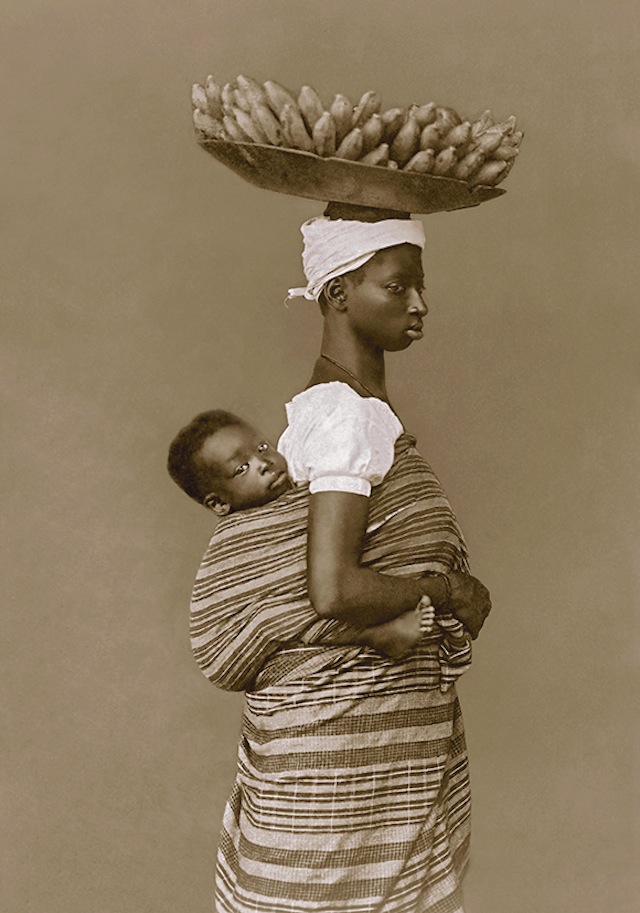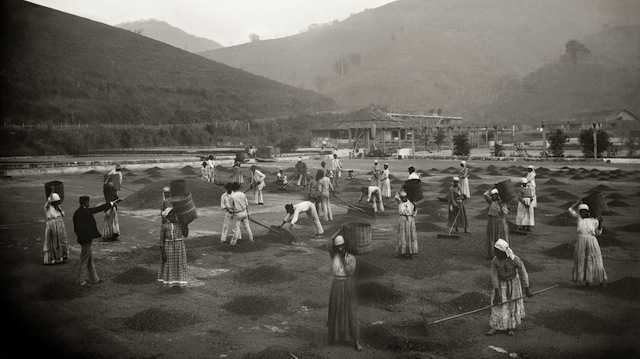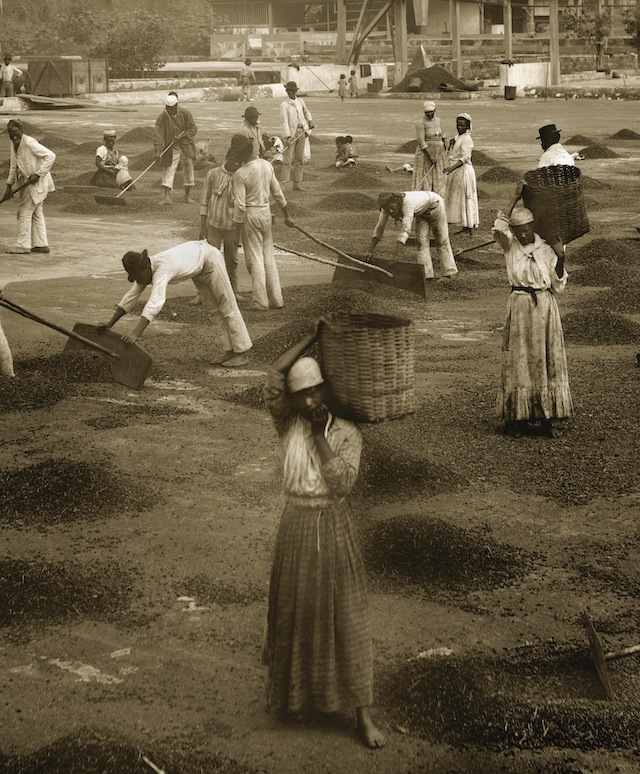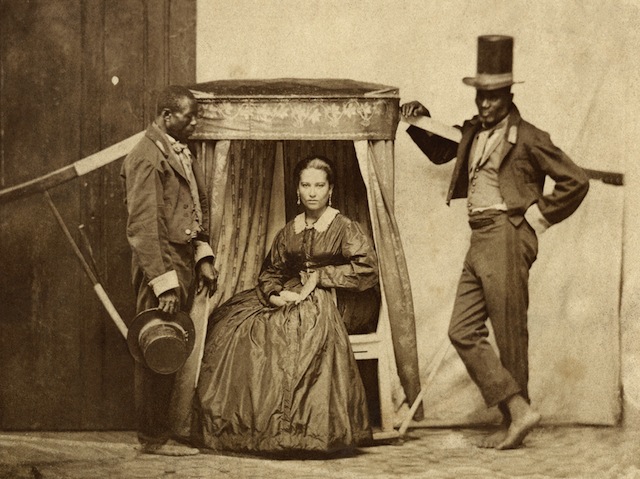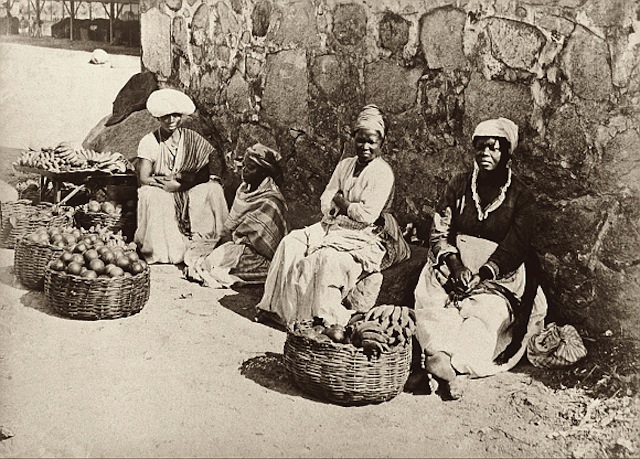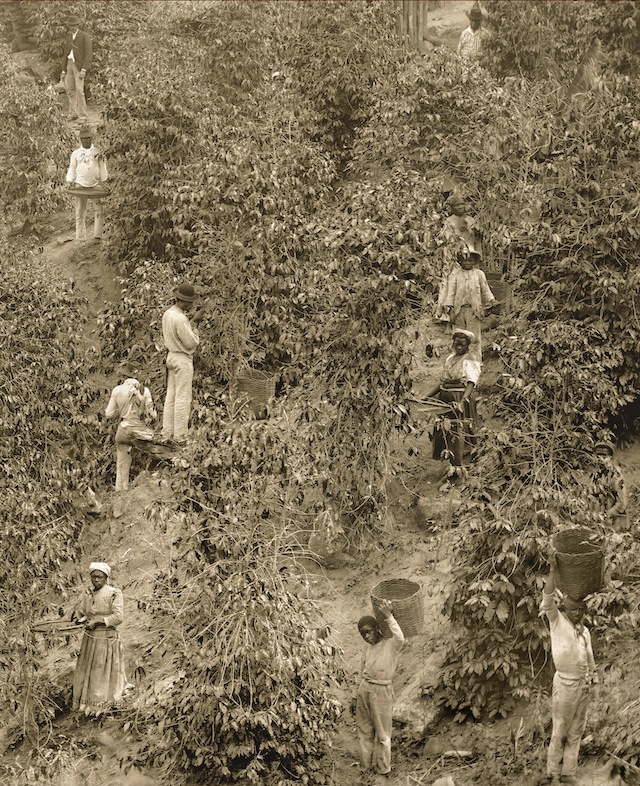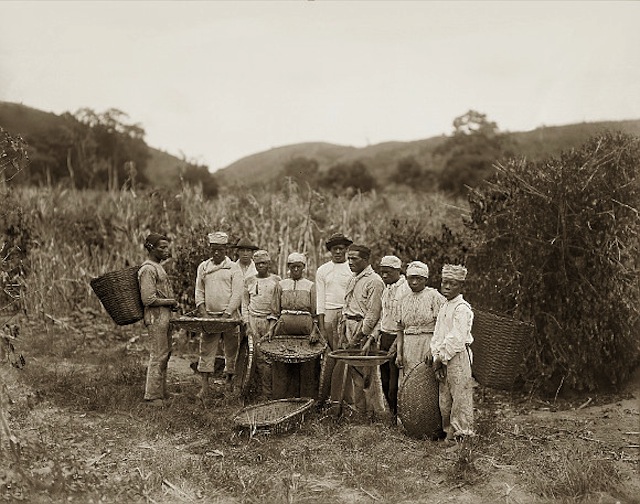
November 12, 2013
Photos Reveal Harsh Detail
Of Brazil’s History With Slavery
>PLAY Brazil Story

Slaves at a coffee yard in a farm. Vale do Paraiba, Sao Paulo, 1882. / Marc Ferrez/Moreira Salles Institute Archive
Brazil was the last place in the Americas to abolish slavery — it didn’t happen until 1888 — and that meant that the final years of the practice were photographed.
This has given Brazil what may be the world’s largest archive of photography of slavery, and a new exhibition in Sao Paulo is offering some new insights into the country’s brutal past.
One image at the exhibition, for example, has been blown up to the size of a wall. “Things that you could never see, suddenly you see,” says anthropologist Lilia Schwarcz, one of the curators of the new exhibition called Emancipation Inclusion and Exclusion.
In its original size and composition, the image from photographer Marc Ferrez, one of the most impressive photographers from 19th century Brazil, shows a wide shot of a group of slaves drying coffee in a field. Their faces are indistinct but the overall impression is one of order and calm. But once the picture is blown up, the expressions become distinct and details emerge. A female slave is breastfeeding a child in the field; clothes that look neat are seen to be tattered.
“Expanding the photos, we can see a lot of things we couldn’t see and the state didn’t want to see,” Schwarcz says. “We do not want to show slaves only like victims.”
Brazil’s History With Slavery
Slavery in Brazil lasted for 300 years, and it imported some 4 million Africans to the country. These images were taken during the waning days of slavery and Brazil’s monarchy. Many were commissioned by the state in an attempt to show slavery in a better light.
Black woman with white child on her back. Bahia, 1860. / Moreira Salles Institute Archive
Sergio Burgi with the Moreira Salles Institute, which donated the photographs to the show, says blowing up the images shows the underlying brutality of the system. In another image, slaves are lined up waiting to be taken into the field. All are barefoot. In between them, once the image is enlarged, we can see many young children.
“Its incredible what you see,” Burgi says. “The amount of children who very early go out … how would they manage to take care of these children out in the fields?”
Lilia Schwarcz says the slave system was based on violence, and the photos, when when viewed closely, show just how violent that system could be. Whats astounding about the exhibition is the variety of situations that slaves were photographed in: not only in the fields but in their owners’ homes, in the city and taking care of the white children of their masters.
One of the most striking images is of a white woman sitting in a litter. The two slaves that would carry her through the streets of the city are standing next to her. One looks down, in deference. The other man is leaning against the litter, his hat tipped at a jaunty angle, staring straight at the camera.
“He’s showing himself, and saying ‘I’m not just like this, I’m another thing. I’m something different. I’m something else,” Schwarcz says.
A detail from a photo of slaves going to the coffee harvest with oxcar. Vale do Paraiba, Sao Paulo, 1885. / Moreira Salles Institute Archive
Opening New Discussions
The images in the exhibition were taken from 1860 to 1885. Slavery ended in Brazil in 1888, and the photos also reveal a tricky and difficult moment for slave owners in Brazil, says Maria Helena Machado, a historian who also contributed to the exhibition.
“It was almost the end of the slave system in Brazil, but those owners … they wanted very much to keep the slave system,” Machado says.
Machado says the late 19th century was even more brutal than before because, with slavery about to end, owners wanted to get as much as they could in terms of slave work. “They are not concerned anymore about surviving, so who cares? ‘I need to get my money back,'” she says.
A lady with two slaves, in Bahia, Brazil, 1860. / Moreira Salles Institute Archive
Machado says many slaves were running away, while others had formed armed bands and were revolting. The enlarged images show the look in the eyes of the slaves. The battle, says Lilia Schwarcz, is very evident.
“They were fighting for their freedom,” she says. “So you have here a discussion about freedom.”
A discussion that curator Sergio Burgi says continues today, with the people who have come to see the exhibition. “People here in Brazil have reacted in very interesting ways saying ‘Oh that reminds me of my time as a kid, and I used to live in a rural area and everything looked similar,'” he says.
Burgi says even decades after slavery, blacks lived in the same conditions, and that legacy continues to resonate today.
The exhibition runs through the end of December at the University of Sao Paulo.
__________________________
Seeking Humanity in the Barbarity of Brazil’s Slave Past
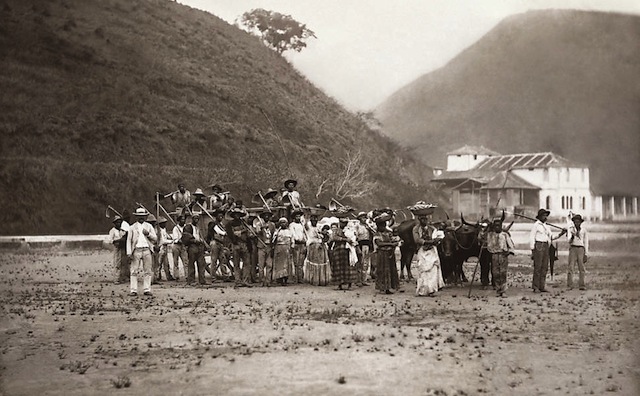
“Departure for the coffee harvest by ox cart, Vale do Paraíba, Brazil, c. 1885″ (all images courtesy of Instituto Moreira Salles)
At the University of São Paulo’s Museum of Contemporary Art, a new exhibition is interrogating Brazil’s legacy of slavery, disrupting a body of photography that was meant to normalize slavery. The pictures were taken by Europeans and Brazilians in the 1860s–80s as a kind of ethnographic endeavor, to present slavery as natural and orderly. In collaboration with the Instituto Moreira Salles, which supplied the 76 photographs in the show, selected pictures were zoomed in on and enlarged, some of them as large as the walls in the exhibit. In doing so, the curators sought a redemptive aspect to the photographs, moments and details — sometimes hidden — that the photographer could capture but not control. Formerly sunk into the sweep and scale of the images, numerous details are lifted out and brought into focus when blown up: dirty, tattered clothing; armies of bare feet; children and infants alongside their parents in the field — glimpses of the barbarity of slavery and the humanity contained within it.

Enlargement and detail of “Departure for the coffee harvest by ox cart, Vale do Paraíba, Brazil, c. 1885″
Submerged personal expressions and gestures are revealed. In the image of “Slaves harvesting coffee, Vale do Paraíba, Brazil, c. 1882,” the enlargement shows many of the people in the group confronting the photographer, their gazes direct, curious, perhaps scornful. One figure has his back to the camera, a defiant gesture or an incidental one. These details stand out in an image that serves as a record of human cruelty. By selecting this cross-section of photos and staging them in such a large format, the curators seek to coax out the many looks, postures, and responses that are embedded but often missed in these visual documents.
This is also an important project because, as a NPR feature on the exhibition noted, Brazil may possess the largest such collection of slavery photography in the world, due in large part to the country’s long history with slavery. In fact, Brazil was the last country in the Americas to legally abolish the practice, in 1888. (Slavery was still legal in the Caribbean until Cuba outlawed it in 1886.) During its 300-year-long participation in the slave trade, Brazil received nearly five million enslaved Africans, or almost one half of the estimated 10.7 million African slaves transported to all of Americans and the Caribbean. Approximately 450,000 Africans are believed to have been transported to the United States.
The Emancipation, Inclusion, and Exclusion exhibition is attempting to open up a significant, yet largely unengaged, corner of Brazilian history. Perhaps it will encourage a better understanding of the worldwide system, a reclaimed vision of the ways people presented themselves and lived amid one of the most painful chapters in human history.
 “Slaves in the coffee harvest, Rio de Janeiro, Brazil, c. 1882″
“Slaves in the coffee harvest, Rio de Janeiro, Brazil, c. 1882″





